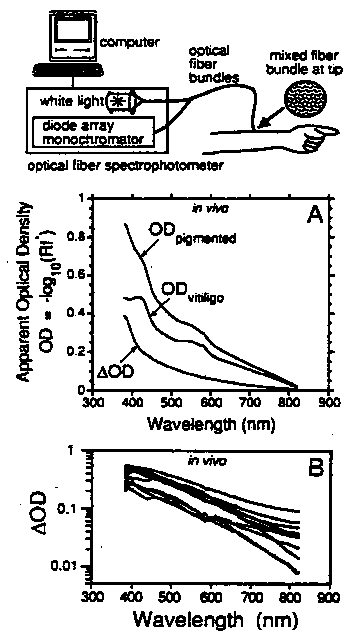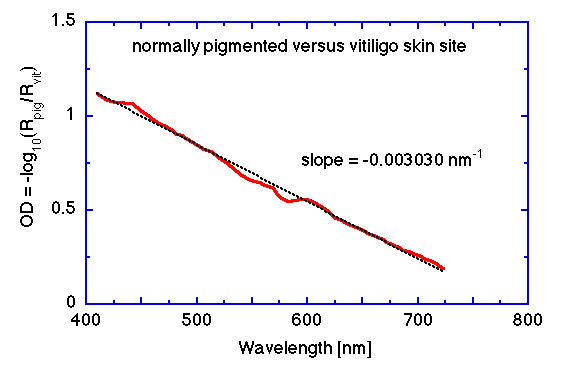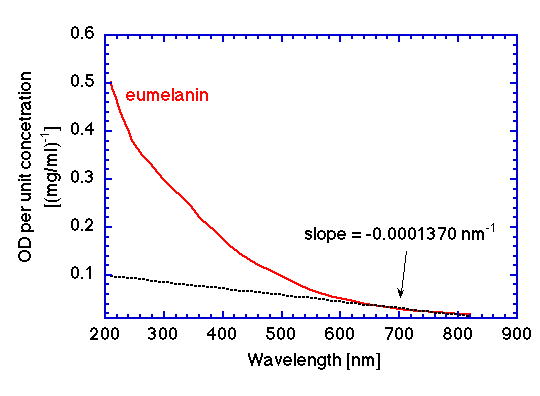How To Tell Depth Of Skin Pigmentation
A very practical question is "how dark is the pigmented epidermis of a peel site?" During pulsed light amplification by stimulated emission of radiation treatments of portwine stain lesions and other vascular lesions, the oestrus degradation in the epidermis is a limiting factor. Epidermal pigmentation can exist pertinent to laser removal of tattoos and laser hair removal as well.
Kollias and Baqer (1986) proposed that one could document epidermal pigmentation past the spectral behavior of skin reflectance in the 620-720 nm range. A measurement (Mskin) of low-cal backscattered from the pare and a measurement (Mstd) of calorie-free backscattered from a reflectance standard of value Rstd are made. These measurements depend on the light source spectrum (Southward), the detector spectral response (D), the fraction of reflected light escaping a medium that is collected past the measurement organisation (f), and the truthful reflectance of the pare:
Thousandskin/Mstd = (SfskinRpareD)/(SfstdRstdD) = Rpeel Rstdfskin/fstd = Rskinf*
where f* = Rstdfskin/fstd, a scale factor. Kollias and Baqer made measurements on a pigmented peel site and on a nearby vitiligo site which is devoid of melanin paint. The ratio of these two measurements would be:
Mpigmented/Mvitiligo = Rpigmentedf*pigmented/(Rvitiligof*vitiligo) = Rpigmented/Rvitiligo
because f*pigmented = f*vitiligo and so cancels out. The f* is not significantly affected past a thin superficial absorbing layer (pigmented epidermis), fskin being dominated by the bulk tissue optical properties below the surface. So the ratio of true reflectances is obtained, and they differ simply by the effect of the pigmented epidermis.
The optical density (OD) of the pigmented epidermis for photons passing twice through the epidermis, in one case upon entering the peel and once upon escape, is divers equally:
OD = -log10(Rpigmented/Rvitiligo)
The post-obit figure illustrates the OD attributed to the pigmented epidermis. Effigy A compares a normal pigmented skin site and a vitiligo site. Figure B compares measurements of the more pigmented dorsal forearm and the less pigmented ventral forearm of 10 subjects, plotting -log10(Rdorsal/Rventral).

Figure: In vivo spectrometer measurements of pigmented epidermis.
(A) Comparison of usually pigmented and vitiligo skin site on arm.
(B) Comparison of dorsal and ventral forearm skin sites.
Figure from Jacques and McAuliffe (1991).
The following figure shows an OD spectrum based on data from Kollias and Baqer for a normally pigmented versus vitiligo site. The gradient d(OD)/d(nm) is -0.003030 nm-ane, where nm denotes wavelength in nanometers.

Effigy: Optical density (OD) of pigmented epidermis. OD = -logten(Rpigmented/Rvitiligo).
In the section of this article on the extinction coefficient, a graph of the extinction coefficient from Sarno and Swartz was presented in units of [cm-1 (mg/ml)-one]. For the in vivo spectrometer measurement, the photons accept passed twice through the approximatley 60-µm thick epidermis, one time entering and one time escaping, so the pathlength is about 120 µm. Hence, the product of extinction coefficient and pathlength yields an optical density per unit concentration [(mg/ml)-1]. The extinction coefficient graph is redrawn beneath as an optical density graph per unit of eumelanin concentration.

Figure: The optical density of eumelanin per unit concentration (mg/ml), assuming a photon pathlength of 120 µm corresponding to a double pass through the epidermis.
The slope between 620-720 nm is shown past a dashed blackness line. The value of the slope d(OD)/d(nm) is -0.0001370 [nm-i (mg/ml)-1]. We can judge the melanin concentration in the above in vivo pigmented site:
(-0.003030 nm-ane)/(-0.0001370 [nm-1 (mg/ml)-ane) = 21.ix mg/ml
Hence it is possible to assign a value of eumelanin concentration to a measured slope d(OD)/d(nm) of a pigmented epidermis. In this case, 21.9 mg/ml of eumelanin corresponded to a slope of -0.003030 nm-one.
Routine measurements with spectrometer
A routine measurement would exist to simply measure out a pare site Mpare, normalized by a measurement of Teflon MTeflon to abolish the light source (Due south) and detector (D) spectral dependencies. For convenience, allow us call this normalized ratio 10:
Mpeel/One thousandTeflon = fskinRskin / (fTeflonRTeflon) = X
In my feel with optical fiber spectrometers using Teflon equally the reference standard, I accept found that vitiligo sites, and extremely lightly pigmented Caucasians, present a 650-800 nm gradient, d(X)/d(nm), that is relatively consistent from individual to individual. For our ii-mm-dia. mixed fiber parcel with Teflon as a reference standard, I institute for vitiligo sites:
d(Ten)/d(nm) = -logten(Thousandpeel/One thousandTeflon) roughly equals -0.000500 nm-1
Therefore, one tin can routinely make measurements on individuals without a convenient vitiligo site and employ this -0.000500 nm-one value as a baseline for zero melanin. This baseline value will vary with the details of one's measurement device, but once determined it should be relatively consequent for all individuals unless there is pregnant edema or changes in pare thickness that affect the baseline reflectance spectrum.
In summary, the melanin content of the pigmented epidermis of skin can be conveniently characterized in units of mg/ml of eumelanin past measurements with an optical fiber spectrometer:
eumelanin [mg/ml] = ( d(X)/d(nm) - (-0.000500) )/(-0.0001370)
REFERENCES:
- N Kollias, A Baqer. On the cess of melanin in man peel in vivo. Photochem. Photobiol. 43:49-54, 1986.
- SL Jacques, DJ McAuliffe. The melanosome: threshold temperature for explosive vaporization and internal assimilation coefficient during pulsed laser irradiation. Photochem. Photobiol. 53:769-775, 1991.
Source: https://omlc.org/spectra/melanin/opticaldepth.html
Posted by: carterpaence.blogspot.com


0 Response to "How To Tell Depth Of Skin Pigmentation"
Post a Comment